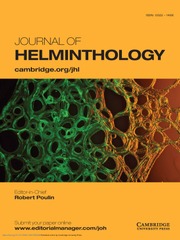Crossref Citations
This article has been cited by the following publications. This list is generated based on data provided by
Crossref.
Gasser, Robin B.
Zhu, Xingquan
and
Chilton, Neil B.
2002.
The Geohelminths: Ascaris, Trichuris and Hookworm.
Vol. 2,
Issue. ,
p.
219.
Vandergast, Amy G.
and
Roderick, George K.
2003.
Mermithid parasitism of Hawaiian Tetragnatha spiders in a fragmented landscape.
Journal of Invertebrate Pathology,
Vol. 84,
Issue. 2,
p.
128.
Li, G.Q.
Hu, Y.L.
Kanu, S.
and
Zhu, X.Q.
2003.
PCR amplification and sequencing of ITS1 rDNA of Culicoides arakawae.
Veterinary Parasitology,
Vol. 112,
Issue. 1-2,
p.
101.
Traversa, Donato
Giangaspero, Annunziata
Galli, Paola
Paoletti, Barbara
Otranto, Domenico
and
Gasser, Robin B
2004.
Specific identification of Habronema microstoma and Habronema muscae (Spirurida, Habronematidae) by PCR using markers in ribosomal DNA.
Molecular and Cellular Probes,
Vol. 18,
Issue. 4,
p.
215.
Sato, Hiroshi
Une, Yumi
Kawakami, Shigehisa
Saito, Eriko
Kamiya, Haruo
Akao, Nobuaki
and
Furuoka, Hidefumi
2005.
Fatal Baylisascaris Larva Migrans in a Colony of Japanese Macaques Kept by a Safari-Style Zoo in Japan.
Journal of Parasitology,
Vol. 91,
Issue. 3,
p.
716.
Fogt-Wyrwas, R.
Jarosz, W.
and
Mizgajska-Wiktor, H.
2007.
Utilizing a polymerase chain reaction method for the detection ofToxocara canisandT. catieggs in soil.
Journal of Helminthology,
Vol. 81,
Issue. 1,
p.
75.
Traversa, Donato
Costanzo, Francesca
Iorio, Raffaella
Aroch, Itamar
and
Lavy, Eran
2007.
Mitochondrial cytochrome c oxidase subunit 1 (cox1) gene sequence of Spirocerca lupi (Nematoda, Spirurida): Avenues for potential implications.
Veterinary Parasitology,
Vol. 146,
Issue. 3-4,
p.
263.
Li, Ming‐Wei
Lin, Rui‐Qing
Song, Hui‐Qun
Sani, Rehana A.
Wu, Xiang‐Yun
and
Zhu, Xing‐Quan
2008.
Electrophoretic analysis of sequence variability in three mitochondrial DNA regions for ascaridoid parasites of human and animal health significance.
ELECTROPHORESIS,
Vol. 29,
Issue. 13,
p.
2912.
Shamsi, Shokoofeh
Gasser, Robin
Beveridge, Ian
and
Alizadeh Shabani, Afshin
2008.
Contracaecum pyripapillatum n. sp. (Nematoda: Anisakidae) and a description of C. multipapillatum (von Drasche, 1882) from the Australian pelican, Pelecanus conspicillatus.
Parasitology Research,
Vol. 103,
Issue. 5,
p.
1031.
Jex, Aaron R.
Waeschenbach, Andrea
Littlewood, D. Timothy J.
Hu, Min
Gasser, Robin B.
and
Unnasch, Thomas Raymond
2008.
The Mitochondrial Genome of Toxocara canis.
PLoS Neglected Tropical Diseases,
Vol. 2,
Issue. 8,
p.
e273.
Smith, Huw
Holland, Celia
Taylor, Mervyn
Magnaval, J-F.
Schantz, Peter
and
Maizels, Rick
2009.
How common is human toxocariasis? Towards standardizing our knowledge.
Trends in Parasitology,
Vol. 25,
Issue. 4,
p.
182.
Traversa, Donato
and
Otranto, Domenico
2009.
Biotechnological advances in the diagnosis of little-known parasitoses of pets.
Parasitology Research,
Vol. 104,
Issue. 2,
p.
209.
Li, Qiao‐Yan
Dong, Shi‐Juan
Zhang, Wei‐Yu
Lin, Rui‐Qing
Wang, Chun‐Ren
Qian, De‐Xing
Lun, Zhao‐Rong
Song, Hui‐Qun
and
Zhu, Xing‐Quan
2009.
Sequence‐related amplified polymorphism, an effective molecular approach for studying genetic variation inFasciolaspp. of human and animal health significance.
ELECTROPHORESIS,
Vol. 30,
Issue. 2,
p.
403.
Shamsi, Shokoofeh
Norman, Richard
Gasser, Robin
and
Beveridge, Ian
2009.
Redescription and genetic characterization of selected Contracaecum spp. (Nematoda: Anisakidae) from various hosts in Australia.
Parasitology Research,
Vol. 104,
Issue. 6,
p.
1507.
Blizzard, Emily L.
Davis, Cheryl D.
Henke, Scott
Long, David B.
Hall, Christopher A.
and
Yabsley, Michael J.
2010.
Distribution, Prevalence, and Genetic Characterization of Baylisascaris procyonis in Selected Areas of Georgia.
Journal of Parasitology,
Vol. 96,
Issue. 6,
p.
1128.
Rubinsky-Elefant, G.
Hirata, C. E.
Yamamoto, J. H.
and
Ferreira, M. U.
2010.
Human toxocariasis: diagnosis, worldwide seroprevalences and clinical expression of the systemic and ocular forms.
Annals of Tropical Medicine & Parasitology,
Vol. 104,
Issue. 1,
p.
3.
Pinelli, Elena
Kortbeek, Laetitia M.
and
van der Giessen, Joke W.B.
2010.
Topley & Wilson's Microbiology and Microbial Infections.
Testini, G.
Papini, R.
Lia, R.P.
Parisi, A.
Dantas-Torres, F.
Traversa, D.
and
Otranto, D.
2011.
New insights into the morphology, molecular characterization and identification of Baylisascaris transfuga (Ascaridida, Ascarididae).
Veterinary Parasitology,
Vol. 175,
Issue. 1-2,
p.
97.
Ai, Lin
Chen, Mu-Xin
Alasaad, Samer
Elsheikha, Hany M
Li, Juan
Li, Hai-Long
Lin, Rui-Qing
Zou, Feng-Cai
Zhu, Xing-Quan
and
Chen, Jia-Xu
2011.
Genetic characterization, species differentiation and detection of Fasciola spp. by molecular approaches.
Parasites & Vectors,
Vol. 4,
Issue. 1,
NADLER, STEVEN A.
and
DE LEÓN, GERARDO PÉREZ-PONCE
2011.
Integrating molecular and morphological approaches for characterizing parasite cryptic species: implications for parasitology.
Parasitology,
Vol. 138,
Issue. 13,
p.
1688.


